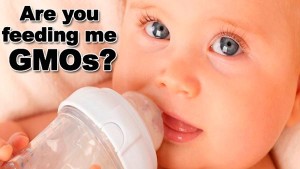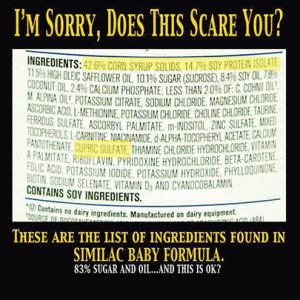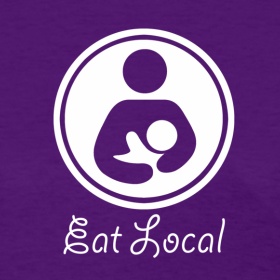Closest to Human Milk – Or is it?
The Truth Behind Infant Formula
By Liza Davenport
 Let me ask you something : Do you think Infant Formula companies would lie about the ‘health’ of their product for the almighty dollar? Most everyone would answer “No”. Think about that, while you read this article….
Let me ask you something : Do you think Infant Formula companies would lie about the ‘health’ of their product for the almighty dollar? Most everyone would answer “No”. Think about that, while you read this article….
In 1865 Chemist Justus von Leibig decided that there had to be another source of infant feeding besides breastfeeding & wet nurses. So he developed, patented and marketed the first ‘infant food’ which consisted of cow’s milk, wheat, malt flour and potassium bicarbonate. Well, the idea caught on because by 1883 there were 27 patented brands of infant food being manufactured {Nestle being among the 27 – but we’ll get back to that company in a bit}
Formula feeding became popular among aristocratic women, since breastfeeding prevented them from wearing the socially acceptable clothing of that time. It was the ‘thing to do’ if you were wealthy, since it was thought that only the poor breastfed their children.
 Infant formula has gone through its years of popularity, and its years of struggle. Infant formula was a huge hit among mothers in the 1930’s, 40’s & 50’s….but then came the 60’s with “Peace & Love”…..oh, and the return of breastfeeding. I’ve seen photos of Woodstock {the big music concert in 1969 – not the town} with women dancing while breastfeeding their babies/toddlers…so cool. It’s weird for me to think that breastfeeding would ever go ‘out of style’…but it did.
Infant formula has gone through its years of popularity, and its years of struggle. Infant formula was a huge hit among mothers in the 1930’s, 40’s & 50’s….but then came the 60’s with “Peace & Love”…..oh, and the return of breastfeeding. I’ve seen photos of Woodstock {the big music concert in 1969 – not the town} with women dancing while breastfeeding their babies/toddlers…so cool. It’s weird for me to think that breastfeeding would ever go ‘out of style’…but it did.
My sister and I (both born in the early 80’s) were breastfed, and I know my mother has told me about people thinking it was strange that she was breastfeeding her children. I was born in Fredericton, and out of all the babies in the maternity ward…I was the only one being breastfed.
But not everyone was a fan of infant formula. In 1977, there was a boycott launched in the US against Nestle about the ‘aggressive marketing’ they were doing, particularly in the less economically developed countries. Even as of 2013 there is still a boycott against Nestle. Over 200 groups in over 100 countries have developed the International Nestle Boycott Committee. Advocacy groups have accused Nestle of using unethical methods to promote infant formula to poor mothers in developing countries.
 What these formula companies do is awful. They send their products to these under developed countries, claiming that all the ‘Western Women’ {States & Canada} are using Infant Formula…therefore enticing these women into buying their product. What happens, though, is that these women can’t afford to buy formula all the time, so they use less formula powder to make a container last longer…or to accommodate more than one child. The children end up not receiving the nutrition that is needed for growth and development since their formula is so watered down.
What these formula companies do is awful. They send their products to these under developed countries, claiming that all the ‘Western Women’ {States & Canada} are using Infant Formula…therefore enticing these women into buying their product. What happens, though, is that these women can’t afford to buy formula all the time, so they use less formula powder to make a container last longer…or to accommodate more than one child. The children end up not receiving the nutrition that is needed for growth and development since their formula is so watered down.
Speaking of water…that is another issue. These ignorant formula companies don’t even care about what kind of water these women would be mixing their formula with! Well I’ll tell you…most of it is contaminated… which leads to so many diseases and even deaths in infants and children. Formula fed children living in disease-ridden conditions are around 25 times more likely to die of diarrhea than a breastfed child living in the same conditions.
But don’t think that formula is healthy for babies if used properly….and here’s why:
If you feed your baby one of the following infant formulas, you are perhaps unknowingly feeding them GMO or Genetically Modified Organisms.
Many of the formulas on the market contain – GMO Corn, Sugar Beets and soy: Similac, Enfamil, and Gerber Good Start (which is made by Nestle)
The Nestle company did go “GMO Free” in South Africa, but continues to sell GMO formula in North America. They have actually dismissed calls and letters to remove the GMO from their infant formula. Which means they are ignoring any concerns from parents with questions about GMO in their children’s formula.
If you have ever researched GMO, you can see all the awful things it does to our bodies. They are now getting the blame for causing all sorts of health problems, including cancer.
But GMO isn’t the only thing parents should be worried about when it comes to infant formula….
When you see the commercials for formula…you often hear the words “Closest to mother’s milk” because it claims to have DHA & ARA which is found naturally in a mothers breast milk. DHA & ARA are long-chain fatty acids. However, the DHA & ARA found in formula is synthetic – not natural! They are made in a lab…not in a mother’s breast. Some infant formulas even contain arsenic…but they usually have that hidden under some fancy name.
Foods that are genetically modified or synthetically made are often recalled, and infant formula has been on that list many times. But I know an infant food that has never been recalled – breast milk!
There is all natural and organic formula on the market…but what people don’t do is look at the ingredients. People see the word organic and automatically think it’s actually organic. Well…most of the time it isn’t. You have to read ingredients!! If you can’t pronounce the words in the ingredients…then odds are, it isn’t organic.
Besides all the health concerns of formula….there is also the financial concern. Formula is expensive, and since it is very popular among low income families they often get help to pay for the product. Infant formula costs the government {and taxpayers} over $500 million a year to provide for their various food programs. So even if you don’t have children…you are still paying for infant formula.
As you can see, Infant Formula companies do not care about the health and well- being of your children…they are concerned about their profit. If they did care about the health of infants/children, they would stop handing out their ‘free samples’ in hospitals and stop sending them to under developed countries where children should be breastfed to help fight off diseases.
So ask yourself again…do you think Infant Formula Companies would lie about the health of their product for the almighty dollar? — Of course they would!
This is the third article in a series on breast feeding by local Lactivist Liza Davenport.
